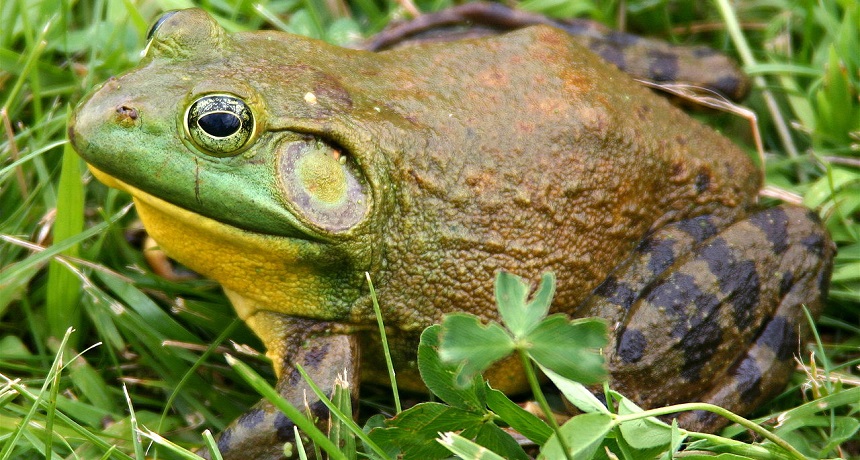Dissect a frog and keep your hands clean
We compare three smartphone frog dissection apps to find the best

The North American Bullfrog is often used for frog dissections. But if you would rather the bullfrog kept hopping, you can try a virtual dissection app.
Carl D. Howe/Wikimedia Commons
Frog dissections are a staple of many middle- and high-school science classes. Learning about anatomy and what each organ does can be fun and exciting. Dissecting also can teach us a lot about the similarities and differences between species (including our own).
But a dead, preserved and stinky frog might be a turn-off for some. And it can be expensive and tough to find a dissecting toolkit, tray and preserved frog. But if you have a smartphone, you can spare the frog without spoiling the experience.
I found three different frog dissection apps available for the iPhone. Each lets you have you peer inside a frog without the usual goop. And while all three provided similar information, the performance of one really leapt over the rest.
Kid Science: Frog Dissection
This app features short videos of a frog dissection. Separate clips display each organ and procedure. The opening segments run through what you will need to do your own dissection and how to open up the frog’s body cavity. Subsequent ones point out organs and describe their functions. A quiz also offers the option to see how much you’ve learned.
All the videos are well produced and star a real frog. Unfortunately, the app is clearly meant as a guide for a student or parent running their own home dissection. There is no way to manipulate images of the frog or to move organs and tissues yourself. You also cannot zoom in or out to see the more difficult features, and the angles the videos take can be confusing for a novice. And I found the music during the videos repetitive and annoying.
Rating: 


$2.99, Available on iTunes for iPhone and iPad
Easy Dissection: Frog by Element Construct
Like the previous app, this one doesn’t let you manipulate the virtual frog yourself. Instead, it lists the internal organs and tissues. Select one from the list and an image appears. An accompanying description explains the function of the depicted tissue. This program does let you zoom in to see things in greater detail. And the images are excellent photos of a real, dissected frog. But the app offers no way to assess what you’ve learned. It is, however, the least expensive of the three.
Rating: 

$0.99, Available on iTunes for iPhone and iPad
Froguts Frog Dissection App
If you’re looking for a fairly faithful dissection experience, this is the place to start. The app is voice- and text-guided. This allows you to probe your digital amphibian with or without sound. Select a male or female frog. You can rotate it, “cut” it open and “pin” different organs and tissues back. Once you insert your digital pin, that pin becomes active. Tapping a pin opens a bubble with information about the pinned organ and the option for a close-up view.
Once you’ve finished your virtual dissection, you can take practice quizzes on frog anatomy and physiology. The only downsides are the rather expensive price tag and the lack of real frog dissection photos. Froguts relies on animated frog models, which offer a less realistic view than the other two apps.
Rating: 




$5.99, Available on iTunes for iPhone and iPad, Google Play and Amazon
Follow Eureka! Lab on Twitter
Power Words
anatomy The study of the organs and tissues of animals. Scientists who work in this field are known as anatomists.
dissection The act of disassembling something to examine how it is put together.In biology, this means opening up animals or plants to view their anatomy.
organ (in biology) Various parts of an organism that perform one or more particular functions. For instance, an ovary makes eggs, the brain interprets nerve signals and a plant’s roots take in nutrients and moisture.
physiology The branch of biology that deals with the everyday functions of living organisms and how their parts function.
tissue Any of the distinct types of material, comprised of cells, which make up animals, plants or fungi. Cells within a tissue work as a unit to perform a particular function in living organisms. Different organs of the human body, for instance, often are made from many different types of tissues. And brain tissue will be very different from bone or heart tissue.
virtual Being almost like something. Something that is virtually real would be almost true or real — but not quite. The term often is used to refer to something that has been modeled by or accomplished by a computer using numbers, not by using real-world parts. So a virtual motor would be one that could be seen on a computer screen and tested by computer programming (but it wouldn’t be a three-dimensional device made from metal).







